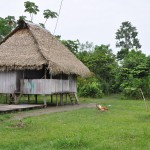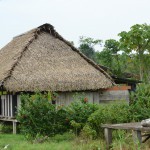This is a three part series on the Kichwa people living near the Yasuni National Park in the eastern Ecuadorian Amazon Basin along the Napo River. In Part 1 of the series, we discuss the village, schools, and infrastructure. In Part 2 of the series, we visit a Kichwa farm. In Part 3 of the series, we visit a cultural center and see how the Kichwa women are working to preserve their culture.
Part 1 – The Village Commune
During our recent trip to the Amazon, we had several opportunities to visit with the local indigenous population. We were able to visit a Kichwa community, a Kichwa farm, and a Kichwa cultural area.
The Kichwa (or Quechua) are an indigenous people in South America. They speak the Kichwa language, which is also the same language the Incas spoke. They are found primarily in Ecuador, Peru, Bolivia, Chile, Colombia, and Argentina. Total population of Kichwa people is between 10 and 11 million people, with about 2.5 million of them in Ecuador.
Our first visit was to a Kichwa commune. A commune is the main village. From the bank of the river, the land opens up into a large dirt soccer pitch. Situated around the pitch are a few government offices, a store, a medical area, a few homes, a power generator station, a community center, and further back behind the pitch, a school.
Most of the buildings are simple wooden structures with a thatched roof. All are on stilts to keep the buildings above the water when the river floods during the wet season. There are generally no doors or windows on the buildings. Just a short wall, then a gap, and then the roof. Part of the building will be walled off completely to provide some privacy. Most of these home are occupied by the teachers who work at the school. The other people live up and down the river on farms
Outside some of the houses there were large square pits filled with water. These pits were about 15 feet wide and 25 feet long, and I do not know how deep. They were stock ponds. The locals would keep fish in them, to have a convenient and easy supply of fresh fish.
Nobody owns their property. All property whether here directly in the commune, or up or down the river, is owned by the community. Each family has a piece of land carved out for themselves. They build their house, raise their crops, but they do not own it outright as we would understand it.
As we walked around the commune, we noticed the different buildings and signs. The government offices were all buzzing with activity. It was election week, and the banners and flags were in full display of all the political parties, the rainbow being the most prominent on display. The rainbow represents the “Pachakutik”, or “Unity Party”, which is the main party of the indigenous peoples. The green flags represent the “PAIS Alianza”, or “Proud and Sovereign Fatherland Alliance”, which is the main party in Ecuador. The “PAIS Alianza” holds most of the power in the Ecuadorean government, and is the party of Ecuador President Rafael Correa.
The medical clinic was empty. I asked about it and was told that a nurse or doctor comes and visits once or twice a week. This was just a place they had set up for when they did come. For emergencies, the city of Coca is about 15 miles upstream, and can be reached in about 1½ hours by motorized boat.
Next door to the medical clinic was the power generator. The only electricity for the entire region comes from this gas powered generator. It was currently broken and apparently had been for a couple of weeks. The locals had no idea when it would be fixed. Even when it is working, it usually only runs for a couple hours each day. That’s it.
We ventured on to the rear of the commune area to the school. This school serves the entire area. Each age group had their own classroom. The classrooms differed from other construction in the area. The buildings were made of cinder blocks instead of wood, and had sheet metal roofing. They were elevated only about 2 feet on tall concrete foundations as opposed to stilts. The buildings had no doors or windows, just openings for doors and windows. Each building housed one classroom, so they were not very big. There was a large roofed structure in the middle of all the classroom buildings. It had no walls, just the roof. It was the “gymnasium”, and housed a couple of basketball goals and could also be used for student assemblies.
One building did have real doors and glass windows. I asked about that and was told that was the computer lab. Out of professional courtesy I was given an exclusive tour of the lab. I was expecting vintage beige PC’s and big bulky CRT monitors. When I entered the lab, I was really surprised. These were new and modern Windows 7 PC’s with flat screen monitors. The doors and windows helped to keep out the moisture to protect the equipment from the high Amazon humidity. Apparently an oil company had donated the lab to the school. What a generous and important contribution to the school and its students! Now, if only they had electricity to actually power the lab. And even on those rare occasions there is electricity, there isn’t any Internet access for the computers to use. I guess the oil company didn’t think about that when they donated the computers.
We visited a class room of children while at the school. They were 7-8 years old, or about second graders. We spoke with the teacher, discussed the classroom, teaching materials and schedules. Both Spanish and Kichwa are taught in the classroom side by side. So, for example, on the color pallet spots on the wall, next to the red one was the Spanish word “rojo” and the Kichwa word “puka”.
The children then sang some songs to us in Spanish and Kichwa, and we sang one song, America the Beautiful, to them in return. This was a nice cultural exchange. While we were singing, several of the older children from other classrooms started peeking in through the window.
We noticed some of the children had uniforms, others did not. Also about half the children had shoes, the other half didn’t. The teacher explained that if the parents request it, the government will provide the uniforms. Some parents need them, others do not. The children not wearing shoes had shoes, they just chose not to wear them. (Kathy thinks this is a wonderful idea.) The school also provides breakfast and lunch to the students.
We also talked about the “schoolboats”. There are two of them. One services everything upstream from the school, and the other services everything downstream. Each morning the “schoolboats” leave and pick up the children for school. Each afternoon they drop them off back at home. The boats travel about 30 minutes in each direction up and down the river. Since all life is situated along the river and not deep in the jungle, this system works well. The “schoolboats” are not much different than the motorized canoe we used to get around in ourselves.
We ended our visit and walked slowly back through the village to our boat. It was easy to reflect on our own lives in contrast to the lives that these people lived here. They have it hard, but they also have it easy.
Same as us. Just different.
Part 1 – The Village Commune
Part 2 – The Farm
Part 3 – Cultural Center














